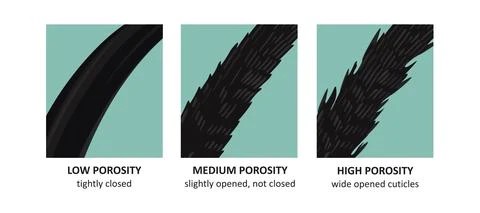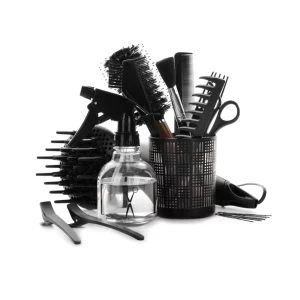Table of Contents
What is hair porosity?
Hair porosity refers to the hair’s ability to absorb and retain moisture. It is determined by the condition of the hair’s cuticle layer, which is the outermost layer of the hair shaft. When the cuticle is tightly closed, the hair has low porosity, meaning it is resistant to moisture penetration. When the cuticle is open, the hair has high porosity, meaning it readily absorbs and loses moisture.

Low Porosity Hair
This hair type has a tightly closed cuticle layer, which makes it difficult for moisture to penetrate the hair shaft. This can result in dry, dull, and frizzy hair that is prone to breakage.
The main characteristics of low porosity hair are:
- Water beads up on the hair: When you try to wet hair, the water beads up and sits on top of the hair rather than being absorbed.
- Slow to dry: Your hair takes longer to dry because the moisture has a hard time penetrating the hair shaft.
- Product buildup: Your hair is more prone to product buildup because the hair doesn’t absorb products well.
To care for your hair, it is important to use lightweight products that won’t weigh down the hair. Clarifying shampoos can also be helpful in removing product buildup. Heat can be used to open up the hair cuticle and help products penetrate the hair shaft. Using a pre-shampoo treatment, such as a hot oil treatment or a steaming treatment, can also help to open up the cuticle.
4 Essential Products for Low Porosity Hair
- African Pride Moisture Miracle Coconut Oil & Baobab Oil Leave-In Hair Cream: As low porosity hair tends to be resistant to moisture penetration, it’s important to choose a lightweight leave-in conditioner that won’t weigh your hair down.
- African Pride Moisture Miracle Honey & Coconut Oil Shampoo: Your hair is more prone to product buildup, so it’s important to use a clarifying shampoo once a week to remove any buildup and help your hair absorb moisture more easily.
- Afrocenchix Natural Scalp Oil – Soothe: This natural scalp oil is specially formulated to provide deep hydration and nourishment to the scalp, which can be especially beneficial for this hair type that struggle to absorb moisture.
- Hair Dryer Steam Bonnet: To help open up those cuticles so more moisture is absorbed.
High Porosity Hair
This hair type has a cuticle layer that is open and allows moisture to easily penetrate the hair shaft. However, the downside is that it also loses moisture just as easily, which can lead to dryness and breakage.
The main characteristics of high porosity hair are:
- Absorbs water easily: Your hair absorbs water easily and can become saturated quickly.
- Dries quickly: Your hair dries quickly because the moisture easily evaporates from the hair.
- Prone to damage: Your hair is more prone to damage because the cuticle layer is open, making it vulnerable to environmental factors like heat and chemicals.
To care for your hair, it is important to use moisturizing products that can help to retain moisture in the hair. Deep conditioning treatments, leave-in conditioners, and hair oils can all help to keep your hair moisturized. It is also important to avoid using heat styling tools too often and to protect the hair from environmental factors like sun exposure and chlorine.
3 Essential Products for High Porosity Hair
- Aunt Jackie’s Oh so Clean! Shampoo: Your hair tends to be dry and brittle, so it’s important to use a moisturizing shampoo that can help to hydrate and nourish the hair.
- Aunt Jackie’s Quench Leave-in Conditioner: A deep conditioning treatment can help to restore moisture to your hair and repair damage caused by heat, chemicals, and environmental factors.
- Cantu Tea Tree & Jojoba Hair/Scalp Oil with Shea Butter: Using a hair oil can help to seal moisture into your hair and prevent it from becoming dry and brittle.
The Water Test
Take a few strands of clean hair and place them in a glass of water. Let them sit for a few minutes. If the hair sinks to the bottom, your hair has high porosity. If it floats on the surface, your hair has low porosity. If it sinks to the middle, your hair is normal/medium.

Once you have determined your hair’s porosity, you can tailor your hair care routine accordingly. For low porosity hair, you may need to use heat to open up the hair cuticle and help products penetrate the hair shaft. For high porosity hair, you may need to focus on using moisturizing products that can help to retain moisture in the hair.
In conclusion
Understanding your hair can help you to choose the right products and care for your hair in a way that promotes its health and beauty. Whether you have hair that needs extra help absorbing moisture, or hair that needs extra help retaining moisture, there are plenty of products and techniques that can help you achieve the best possible results.
Thank you for reading all my curly kings and queens, stay tuned for more!


